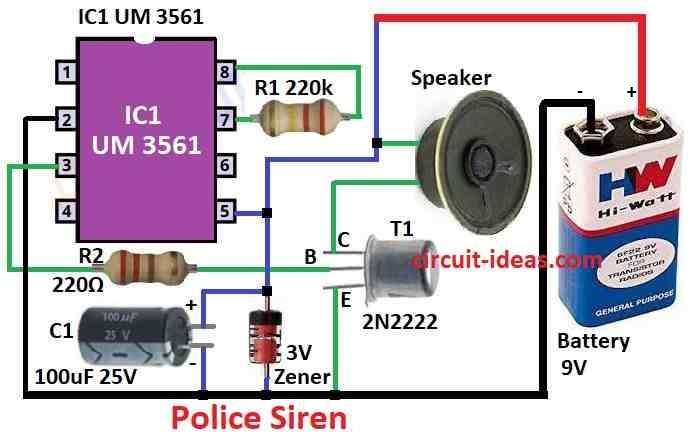This Simple Multi Siren Tones Circuit using IC UM3561 chip is like small sound box for emergency car sound.
This special chip UM3561 can make many siren noise like police car “wee woo” or ambulance fast tone.
It only needs few more parts and one speaker, then this circuit can make those sound come alive.
Beep boop, wee woo wee woo, rat tat tat are some sounds one can choose.
Circuit Working:

Parts List of police siren circuit:
| Category | Component | Quantity | Notes |
|---|---|---|---|
| Resistors | 220k 1/4 watt | 1 | |
| 220Ω 1/4 watt | 1 | ||
| Capacitors | Electrolytic 100µF 25V | 1 | |
| Semiconductors | IC UM3561 | 1 | |
| Transistor 2N2222 | 1 | ||
| Zener diode 3V | 1 | ||
| Speaker | 1 | ||
| Battery 9V | 1 |
UM3561 is small chip that make many siren sound like police, ambulance, fire truck and gun noise.
It has 8 pins and it work with low power and with only 2.4 volts which is okay
This chip are mostly used in toys.
Inside it already have sound maker oscillator and pin to choose sound.
To make siren sound no need of many parts.
Just need one resistor and one transistor for speaker.
Resistor connects to pin 7 (OSC1) and pin 8 (OSC2), this control how fast sound is (frequency).
If one uses 220k resistor then sound usually works good.
Then chip sends signal to control part and it uses pin 6 (SEL1) and pin 1 (SEL2) to choose this sound.
Signal go to counter and ROM inside chip and final sound come out from pin 3.
But sound is not loud so there is need of an amplifier.
One small NPN transistor can do this job.
To change siren sound just change wire on SEL1 pin 6 and SEL2 pin 1 which is like this:
| SEL1 (Pin 6) | SEL2 (Pin 1) | Sound |
|---|---|---|
| Not connect | Not connect | Police siren |
| +3V | Not connect | Fire engine |
| Ground | Not connect | Ambulance siren |
| Not connect | +3V | Machine gun sound |
So just connect UM3561 like in picture and one can get many cool siren sounds like fire, ambulance, gun and more.

Formulas and Calculations:
Formulas and Calculations (Easy Way):
We have used UM3561 chip and some parts to make simple multi-tone siren circuit. This chip makes many sound effects like police or gun. Below is how we do some math to make it work right:
Speaker Current:
UM3561 signal connects to transistor and transistor make sound louder for speaker.
To imagine speaker current use this formula:
ISpeaker = (V − VCE(sat)) / RSpeaker
where,
- VCE(sat) is small voltage loss in transistor around 0.2V
- RSpeaker is speaker resistance like 8 ohms
So if power is 9V and speaker is 8Ω:
ISpeaker = (9V − 0.2V) / 8Ω = 1.1A
But this is only theory.
In actual life transistor and speaker might not handle that much current.
Transistor Base Resistor:
This resistor controls how much current goes from UM3561 to transistor like 2N2222 base.
It helps turn transistor ON fully.
Use this formula:
IBase = (VOUT − VBE) / RBase
where,
- VOUT is chip output around 9V
- VBE is voltage between transistor base & emitter which is about 0.7V
- RBase is base resistor say 220Ω
So:
IBase = (9V − 0.7V) / 220Ω = 38.6mA
This current is enough to turn transistor fully ON which is called saturation so speaker gets full power.
Extra Notes:
UM3561 make different tones.
2N2222 transistor boost sound for speaker.
Zener diode give stable voltage.
Capacitor clean the power line and filter noise.
We can change resistor value if the parts are different or need fine tuning.
How to Build:
To build a Simple Multi Siren Tones Circuit using IC UM3561 one need to follow the below mentioned steps:
Connect UM3561 Chip:
Put UM3561 IC on breadboard.
- Connect pin 2 (VSS) to ground.
- Connect pin 3 (OUT) to transistor 2N2222 base using 220Ω resistor R1.
Make Oscillator Circuit:
- Take 220k resistor connect between pin 7 (OSC1) and pin 8 (OSC2).
- This resistor control how fast sound come from oscillator frequency.
Add Transistor:
- Use NPN transistor 2N2222.
- Connect collector to positive terminal of speaker.
- Connect emitter to ground.
- Connect pin 3 of UM3561 to transistor base using another 220Ω resistor.
Connect Speaker:
- One wire of speaker connects to collector of transistor.
- Other wire of speaker connect to VCC of positive voltage.
- Give power to the circuit using 2.4V to 5V.
- Now one can hear siren sound from speaker
Note:
- Always check UM3561 datasheet for correct pin number and setup.
- Be careful and connect wires with right + positive and – negative polarity or else may damage components.
Conclusion:
Simple Multi Siren Tones Circuit using IC UM3561 chip is easy and cheap way to make many siren sounds.
With just small number of parts and the UM3561s built-in sound maker and tone select pins one can build cool siren generator.
It is good for toys or fun hobby projects.
This circuit can make sounds like police, ambulance, fire truck and even machine gun which is great way to add fun sound effects to our work
Leave a Reply